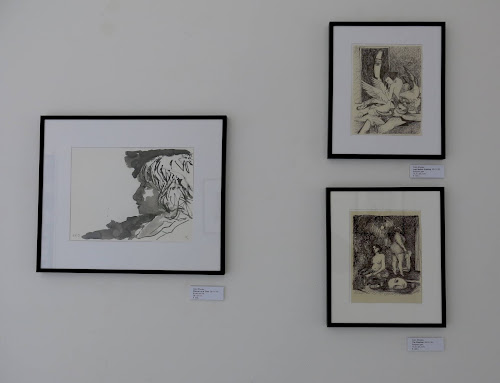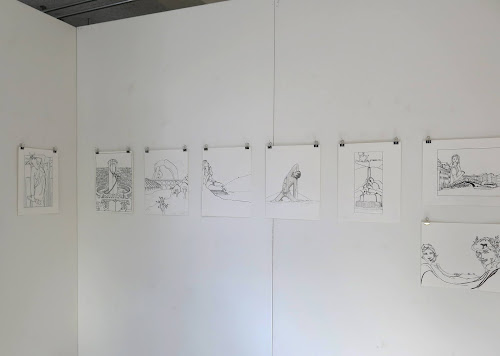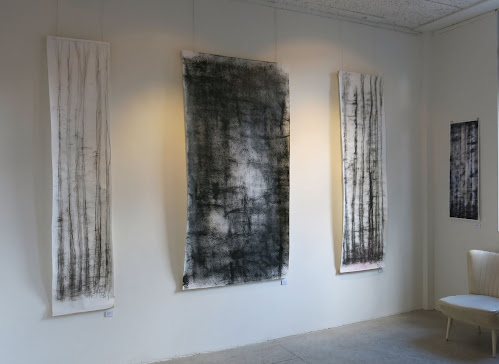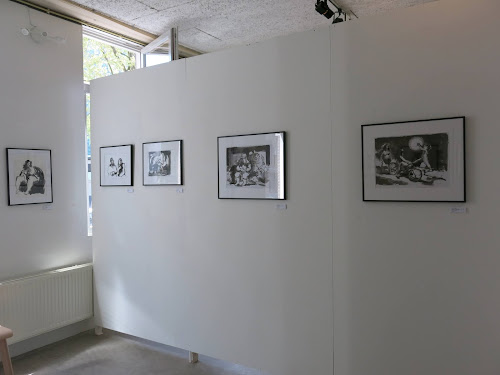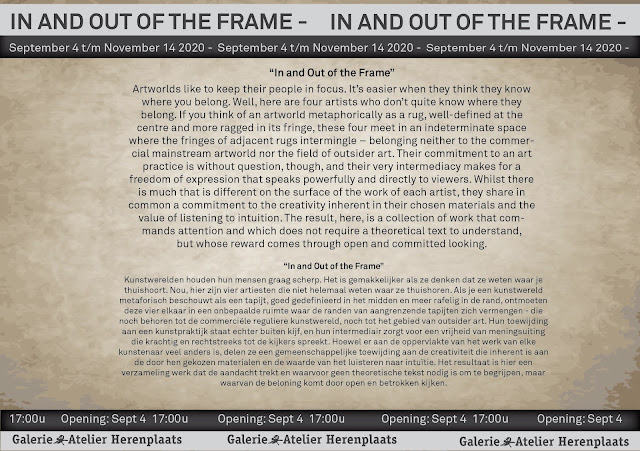Thoughts on current museum culture
What a difference a decade and a half makes. An article published in today's Guardian online (1) couldn't be further away in approach and focus than another from 2004 ostensibly on the same subject, in the same newspaper. (2) The subject of both is Canadian American artist, Philip Guston (1913-1980). Titled, "An Everyday Genius", the earlier piece, by Sean O'Hagan, reviews the retrospective held at the Royal Academy of Arts, London 16 years ago. Today's article, by Edward Helmore, "Sense or censorship? Row over Klan images in Tate's postponed show", covers the announcement that a projected "major retrospective" of Guston's work, planned by four major international art museums has been postponed until at least 2024.
O'Hagan's 2004 review focuses on Guston's artistic journey, providing context through the times in which he lived and his personal relationships. Crucially, and probably unsurprisingly, both the choice of illustration for O'Hagan's piece - Guston's famous self-portrait, The Studio (1969) - and his opening gambit focus on the celebrated abstractionist's return to figurative painting at the end of the 1960s: "In the Thirties, he had been a politically aware mural painter," O'Hagan tells us, "and now, 40 years later, he felt the need to respond once again to an America that was wearied by a long unwinnable war abroad and simmering social discontent at home; a country that was in the grip of a new conservatism." Sound familiar? Ironic, then, that backlash from the very people who are currently engaging in political struggle against the dominant (conservative and populist) ideology appears to be what the museums fear most.
Those new paintings by Guston commonly included hooded figures that can be read as Ku Klux Klansmen. Or, says O'Hagan (and, I'd be more tempted to say), "something more personally emblematic: the masks that artists, like all of us, hide behind; the disguises we don to face or shy away from the world; the evil, banal and faceless, that lurks within us all." In other words, Guston's late paintings are richly complex and densely layered: in terms of their manifest and latent content (their intellectual content, if you will); and from the perspective of the way they operate as painting (their status as manufactured objects of visual culture). They are intensely political, but do not reveal their 'message' in crisp one-liners. Like all good poetry, Guston's figurative painting is allusive and multivalent; it demands the active (contemplative) attention of the viewer.
This is something that the National Gallery of Art in Washington, the Boston and Houston Museums of Fine Art, and Tate Modern that have now announced the postponement of their planned "major retrospective" of Guston's work would agree with. The problem, it would appear, lies with the show's likely public reception. Thus, the "everyday genius" of O'Hagan's article is now rendered a dangerous commodity. Today's article is well-balanced and thoughtful but focuses (necessarily) not so much on the art as on museum politics and funding. It is a sad inditement of where things stand in the state of contemporary museum culture in the West.
Guston's work, in this is instance, is caught in the crossfire, so to speak; like so much other interesting and important art seems to be these days. At the centre of all of the bruhaha is an implicit presumption by the museums themselves that their audiences are incapable of contemplating art in thoughtful and sophisticated ways: Helmore quotes National Gallery of Art source, “There is a risk that [Guston's paintings] may be misinterpreted and the resulting response overshadow the totality of his work and legacy." Moreover, this hypothesised audience is further infantilised by a perceived need to protect it from harm: "the museum wanted to avoid 'painful' experiences the imagery could cause for viewers." Dangerous work indeed!
The museological impulse to 'inform' viewers about the ideas behind exhibitions and the works they contain really, through wall texts and audio guides, begins in earnest with the emergence of a 'new museology' in the 1970s and '80s, and a desire to better help inform and assist audiences in their apprehension and enjoyment of the museum experience. What was to be provided was interpretation; the impulse was neither to 'protect' sensibilities nor to appease particular, or multiple, entrenched viewpoints. Yet, it can sometimes seem like we have arrived at a point at which full-time, institutional curators believe that they are capable of producing didactic truths in their contextual texts and audio, drawn from a generally shared pool of theory and socio-historical belief that has ossified as dogma.
Realistically, there is an assumption among museum administrators and their curators that even those people who will not visit the museum have to be listened to. This is in no small part because public museums have come to be seen as symbolically important politically (not least because they have been increasingly forced to become a constitutive part of the 'leisure industry'). Thus, there is a nexus of groups that is interested in the symbolic identity of the museum and its function which, by means of their public behaviours and interactivities, either threaten or vouchsafe the museum's continued existence. Public museums rely on public money (tax dollars) and government patronage for their financial viability. In the US especially (though not exclusively), they also rely on the continued support (political and financial) of boards of trustees. Sponsorship by business is particularly important (nowadays often essential) for the realisation of special projects and individual exhibitions. And they rely on additional direct public funding, through ticket admissions and the sale of museum products. The withdrawal of any of these sources of patronage would endanger the continued viability of the institution. There is much at stake. And with the museum as political symbol having become, it seems, a legitimate target for political attack from all sides, with little evidence (at least if current mass media reports are anything to go by) of any side using it in a fundamentally supportive way, there is a real sense that the institution is endangered. To complicate things further, much current museum curatorial received wisdom is also inherently (and publicly) antagonistic to the institutions it serves - a political positioning that is at the very least double-edged. Little wonder that museum administrators tasked with maintaining financial viability and, put bluntly, political neutrality, find themselves in a truly divisive and unenviable position.
To be fair, Helmore notes that Mark Godfrey, Tate Modern's Senior Curator of International Art, has said that the decision regarding the Guston retrospective "is actually extremely patronising to viewers, who are assumed not to be able to appreciate the nuance and politics of Guston’s works”. However, I suspect the issue at the heart of all this is the effect wrought by the mishmash of political fighting, both ideological and in the realm of realpolitik, that converge on the museum, its collections and exhibition practice. Competing groups outside the museum appear to be saying that its purpose is to tell us all what to think; 'goodthink', perhaps, to quote Orwell. The problem, of course, is that there is disagreement on exactly what that is. And the public museum's multiple stakeholder groups (that is, whether directly or indirectly, its funders) represent every one of these competing ideologies.
Although it is perhaps understandable that much of the wider political battle is being waged with slogans and the blunt instrument of the dialectic, 'bumper sticker' criticism is surely not appropriate in the museum? And most especially in the case of works of art, which are, by their nature multivalent. A work of art cannot be reduced its definitive essence (or explained away, for that matter). This has been the common mistake of much academic art history and criticism (unlike literary criticism), which habitually looks past the work to engage with issues of intentionality, psychology, and the conditions of its production. Too often the work itself is rendered mute. But then, works of art don't 'speak' in simple phrases, and their valency is altered according to the time and place in which they are viewed, and by the subjectivity of each new viewer. As O'Hagan says, "Sinister, but oddly humorous too. Put simply, Guston's late paintings confuse and confound, disturb and dismay in equal measure; they are often vulgarly funny and utterly ominous." I'm not convinced that any amount of framing by “additional perspectives and voices” will neutralise the disturbing beauty of this particular body of work. What then?
Faced with a far less accommodating dominant culture than currently prevails in the West, the Berlin Dada group used art as a weapon. They staged their own exhibitions, fully expecting the authorities to close them down. And, in due course, their revolt was appropriated and assimilated into the museum. Rather than watching an unedifying spectacle of public museums tying themselves in knots worrying whether they can possibly appease everyone with a stone to throw, it would be nice to think that new art was being utilised in the fights of today, created without public funding, and presented outside institutional contexts, and invading the dominant culture. Where are the Dadaists when you need them?
